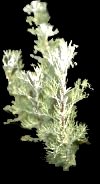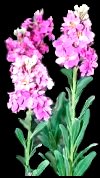|
**disclaimer: If any of the images belong to you and if you want credit or want them removed please email me**
MEANINGS & LEGENDS OF FLOWERS (S)

 Southernwood
Southernwood
Artemisia abrotanum
Family: Compositae
Common Names: ~Old Man~ ~Lad's Love~ ~Boy's Love~ ~Appleringie~ ~Garderobe Herb~ ~Our Lord's Wood~ ~Garden Sagebrush~ ~European Sage~
Found in Europe and Great Britain. Artemisia was named for the Goddess Artemis. Historically used as strewing herb. It was the custom for women to carry large bunches of this plant and balm to church, to prevent drowsiness.
Southernwood known as the herb of love, is ruled by Mercury. It is associated with sexual appeal and has been used by males to increase their virility. Southernwood was put under mattresses in Ancient Greece and Rome for its aphrodisiacal properties. Its common nickname, ~Lad's Love,~ refers to the habit of including a spray of the plant in country bouquets presented by lovers to their lasses in order to seduce them. Represents fidelity.
Southernwood was the most potent antidote for magic potions. Reputed to ward off evil spirits and infection it was used as an antiseptic and as a hair tonic for curing baldness. The ointment was used to stimulate beard growth.
It kept snakes away and protected people from thieves. It was said that the plant can cause impotence.
The pungent, scented leaves and flowers are used in herbal teas. Young shoots were used to flavor pastries and puddings. In Italy, it is used as a culinary herb. Branches produce a deep yellow dye for use with wool. Its used as an insect and moth repellent (the reason why the French call the plant ~Garderobe~ ).

 Spikenard
Spikenard
Aralia racemosa L.
Family: Araliaceae
Common Names: ~Spignet~ ~Life of Man~ ~Pettymorell~ ~Old Man's Root~ ~Indian Spikenard~ ~Indian Root~
Spikenard is a tall, bushy plant, a member of the ginseng family, has large compound leaves. Spikenard is mentioned in the Songs of Solomon in the Bible. Mary used this herb to anoint Jesus before the Last Supper. It is one of the early aromatics used by the ancient Egyptians. It was also used by the Roman perfumers in the preparation of naardinum, one of their most popular scented oils.

 Star of Bethelem
Star of Bethelem
Ornithogalum umbellatum
Family: Liliaceae
Common Names: ~Doves Dung~ ~Chincherinchee~ ~Sleepydick ~
Native of Africa, Europe and west Asia, Star of Bethelem gets it's name from the Greek words ~ornis~ meaning ~bird~ and ~gala~ meaning ~milk.~ Together meaning ~bird's milk.~ It grows abundantly throughout the Holy Land.
The bulb of this plant was valued in times of famine because it was dug up, dried, roasted and was eaten. In Italy, the bulbs are eaten like chestnuts after roasting or cooking till today. For centuries Syrians used it for food. The bulbs are edible when cooked, but all parts should be considered poisonous. It is harmful to livestock and children. Has a vase life of 21 days if properly cared for.

 Statice
Statice
Limonium sinuatum syn. Statice sinuata
Plumbaginaceae
Common Names: ~Marsh Rosemary~ ~Inkroot~ ~Sea-Lavender~ ~Misty~ ~Latifolia~ ~Sea Foam~ ~Caspia~
Known as sea-lavender because it grows wild in salt-marshes. The Greek word Statice means ~using to stand~ as the spikes stand fresh-looking for months. ~Limonium~ is an ancient Greek name, derived from the word ~meadow.~
Statice is popular as a flower filler in arrangements. Dried by hanging upside down for several days. Dried, it retains its colour and can be used to enhance potted plants and dried arrangements. Statice can last up to 14 days.

 St. John's-wort
St. John's-wort
Hypericum perforatum L.
Family: Hypericaceae
Common Names: ~Amber Touch-and-Heal~ ~Goatweed~ ~Klamath Weed~ ~Rosin Rose~
Chinese: ~Xiao Lianqiao~ (Little Forsythia)
Commonly known as St. John's Wort for St. John the Baptist. Traditionally, the leaves of St. John's Wort get stained with red spots on 29th August, the day St. John the Baptist was beheaded. ~Wort~ is the Olde English word for ~plant.~ Its name ~Hyperieum~ is derived from the Greek and means ~over an apparition~ in reference to the belief that the herb was so obnoxious to evil spirits that a whiff of it would cause them to fly. It's ancient name, ~Fuga Daemonum~ also referred to it's power of driving away evil spirits. The night of St. John has been celebrated all over the world by peasant girls who hang the plant over their doors, and sleep with it under their pillows, to get rid of evil spells, or to fortell who their future husbands will be.
St. John's Wort is gathered on Midsummer Eve for fertility. Prussian servants, especially maids, were sent to gather it. A plant was hung up in the house for each member of the family. The remaining plants were bundled, tied to a pole, and set up where grain would be brought at the next harvest. It was believed that one would die if the plant failed to bloom. Used for protection, power, strength, health, happiness, divination and money spells, it acts as a talisman against evil and negative forces and was worn as an amulet. In olden days Saint John's Wort was used for exorcism. Believed to protect the home against lightening, fires, and storms, a common custom is to burn Saint John's Wort in the fireplace and let it's smoke permeate all the rooms.
The root, gathered at sunrise on May Day, brings good luck to the family for its undertakings, especially those begun on that day. Symbolizes the Wiccan festival of Summer Solstice. Leaves and flowers yield a red essential oil but dangerous to grazing animals. In the Language of Flowers it symbolizes Animosity and Superstition.

 Stock
Matthiola incana
Stock
Matthiola incana
Family: Brassicaceae
Common Names: ~Stock~ ~Bromptom, Bromptom~
Originated in the Mediterranean region and the Canary Islands. Named for the Italian physician and botanist Pierandrea Mattioli (1500-1577). The word ~incana~ means ~hoary~ in reference to the plant's typically fuzzy stem. This spicy scented flower is available throughout the year. It is a popular cut flower and has a vase life of 6 to 7 days.

 Straw Flower
Straw Flower
Helichrysum bracteatum
Family: Asteraceae
Common Names: ~Everlasting~ ~Paper Daisy~ ~Immortelles~
Strawflowers are native to Australia. There are about 150 annual and perennial species native to Africa and South America. The scientific name is derived from the Greek word helios meaning ~sun~ and chrysos meaning ~golden.~ Known as an ~everlasting~ because the flowers will last indefinitely when dried.
Available in many colors. Flowers may be dried or pressed. The plant is said to have medicinal value. No scent when fresh, but after drying the smell is said to repel moths. Blooms spring to autumn.

 Sturt's Desert Rose
Sturt's Desert Rose
Gossypium sturtianum var. sturtianum
Family: Malvaceae
Common Names: ~Darling River Rose~ ~Cotton Rosebush~ ~Australian Cotton~
Found in tropical and sub-tropical areas of Africa, Asia, Australia and the Americas. It's name is derived from the Latin ~gossypion~ used by Pliny for the cotton tree, Gossypium arboreum. The name sturtianum, is in honour of Captain Charles Sturt (1795-1869). It was first collected by Captain Charles Sturt "in the beds of the creeks on the Barrier Range" during his journey to central Australia in 1844-45. Scottish botanist, Robert Brown described the plant in 1849 and named it Sturtia Gossypioides. The species has undergone several changes in name, and in 1947 J.H. Willis of the National Herbarium of Victoria gave the name by which it is currently known, Gossypium sturtianum var. sturtianum.
On 12 July 1961, Sturt's Desert Rose was proclaimed floral emblem of the Northern Territory by the Commonwealth
Government. Sturt's Desert Rose has been incorporated into various insignia and so become symbolic of the region.

 Sunflower
Sunflower
Helianthus annuus
Family: Asteraceae (Daisy family)
Sunflowers originated in North America in 3000 BC. During the 1500s, explorers brought the sunflower to Europe, where it spread along trade routes to Russia, Egypt, and the Far East. There are over 150 species of sunflowers. Some grow as high as 15 feet, while the dwarf plants grow 2-3 feet tall only.
Helianthus comes from the Greek ~Helios~ which means ~sun~ and ~anthos~ which means ~flower.~
These flowers always turn towards the sun. They were grown for their usefulness, not their beauty. In 1532 Francisco Pizarro reported seeing the natives of the Inca Empire in Peru worshipping a giant sunflower. Incan priestesses wore large sunflower disks made of gold on their garments.
According to Greek mythology, there was once a water-nymph, who fell in love with Apollo, the God of the Sun. She was so in love with him that she sat on the ground and stared up at the sun all day long. Apollo never noticed her. The other gods, however, took pity on the young girl and turned her into the sunflower. This is why the sunflower forever follows the path of the sun in the sky. She does not want to lose site of her lover.
Another legend tells that Clytie, a nymph loved Helius the Sun god, but he scorned her in favour of another girl called Leucothoe. In a fit of jealousy Clytie told the affair to Leucothoe's father, King Orchamus of Persia, who then buried his daughter alive as a punishment. Helius hated Clytie even more, and poor Clytie wasted away and became the sunflower, whose head turns to follow the course of the sun across the sky each day.
Sunflowers represented different meanings in many cultures. In China they symbolized longevity. In the Andes Mountains, golden images of sunflowers were found in temples. They were used by Central and North American natives to make oil for food, medicine, and dye. North America Indians in the prairies placed bowls of sunflower seeds on the graves of their dead. It is said that if a girl puts three sunflower seeds down her back, she will marry the first boy she meets. The sunflower's turning as it follows the sun symbolizes deep loyalty and constancy also symbolizes power, warmth, and nourishment (all the attributes of the sun), as well as haughtiness, false appearances and unhappy love. The dwarf sunflower satands for adoration in the language of flowers.
Sunflower is grown for the seeds and oil it produces. Each mature flower yields 40% of its weight as oil. One sunflower head can produce up to 1,000 seeds.
Sunflowers have become the symbol of a world free of nuclear weapons. After Ukraine gave up its last nuclear warhead, the Defense Ministers of the U.S., Russia, and Ukraine met on a former Ukranian missile base on June 4, 1996. They celebrated by scattering sunflower seeds and planting sunflowers.
1996 was designated the Year of the Sunflower by the National Garden Bureau. The offical state flower of Kansas is Helicanthus annus, a species of sunflower. Kansas is known as the Sunflower State.

 Sweet pea
Sweet pea
Lathyrus odoratus
Family: Leguminosae
Common Names: ~Queen of Annuals~
Sweet peas derive their name from the Greek word, ~lathyros~ for ~pea~ or ~pulse,~ and the Latin word ~odoratus~ means ~fragrant.~ Sweet peas were popular during the late 19th century and were widely grown in 1722 for their sweet fragrance. The meaning of Sweet Pea is ~blissful pleasure~
Sweet peas are considered to be the floral emblem for Edwardian England and were an important part of floral arrangements for every wedding and dinner party. Dried petals of sweet peas was one of the most important ingredients for potpourris.
According to superstition, seeds sown before sunrise on Saint Patrick's day will have larger and more fragrant blossoms. Others believe the same results will occur if seeds are sown anytime between the feasts of Saints David and Chad ~March 1 and 2~ and of Saint Benedict ~March 21~
The name ~sweet pea~ is believed to have first been used by the poet Keats (1795-1821).
Sweet pea flowers naturally self pollinate while still in bud. They are not edible.
They come in a large range of colors, but not yellow.
The Sweet pea is the flower of the month of April.
|


Copyright © Pinkie D'Cruz 1998
Friday, January 16, 1998


|